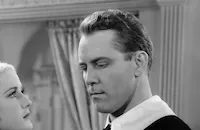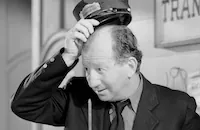Bullets for O'Hara

Brief Synopsis
Cast & Crew
William K. Howard
Joan Perry
Roger Pryor
Anthony Quinn
Maris Wrixon
Dick Purcell
Film Details
Technical Specs

Synopsis
In Florida, newly married Patricia Van Dyne is stunned when her husband Tony robs the home of their society hosts, Elaine and McKay Standish. Although Pat resists, Tony forces her to flee with him and his gang. When they are alone, he promises to kill any man who comes between them. The police trace them to a train headed for Chicago, but Tony escapes, leaving Pat to face the police. Mike O'Hara, the police detective assigned to the case, does not believe Pat when she insists that she knew nothing of Tony's business. Despite his feelings, he arranges for a good defense lawyer for Pat, hoping that she will agree to lure Tony from his hideout. Pat is acquitted, and the Standishes, who firmly believe in her innocence, invite her to stay with them until her divorce is final. When news of Pat's impending divorce fails to attract Tony, Mike's supervisor suggests that he pretend to marry Pat. Pat reluctantly agrees to the plan, but Tony's men spot the police in attendance and do not stop the ceremony. Although Pat and Mike are not in love, they are nonetheless legally married and leave for a honeymoon. At their hotel, Tony and his men easily overpower Pat and Mike's guards and force Pat to leave with them. After a high-speed chase, the criminals arrive at small town in the Florida Keys, from which they intend to travel to Havana. That night, alone in her room, Pat cuts the telephone wire outside her window and attaches a note with Mike's name and number. The repairmen contact the police, who rescue Pat after a shootout kills Tony. Returning home, Mike apologizes to Pat and tells her she can have a divorce whenever she wants. To Mike's delight, Pat responds that she will not need a divorce as she never intends to get married again--she is happy with the marriage she already has.

Director

William K. Howard
Cast

Joan Perry

Roger Pryor

Anthony Quinn

Maris Wrixon

Dick Purcell

Hobart Bosworth

Richard Ainley
Dewolf Hopper
Joan Winfield
Roland Drew
Joseph King
Victor Zimmerman

Hank Mann
Kenneth Harlan
Frank Mayo

Jack Mower
Sidney Bracey
Leah Baird
Jean Maddox
Creighton Hale

Frank Ferguson
Alexander Leftwich

George Irving
William Roberts
Murray Alper
Billy Wayne

Tom Wilson
Glen Cavender
Crew
Abem Finkel
Stanley Fleischer
Frank Fox
Bryan Foy
James Gibbon
Damon Giffard
Les Guthrie
William Jacobs
Charles Lang
Ted Mccord
Raymond Schrock
Perc Westmore
P. J. Wolfson

Film Details
Technical Specs

Articles
Bullets for O'Hara - Bullets For O'Hara
Things appeared to be looking up when studio head Jack Warner called the 26-year-old actor into his office to discuss playing the lead role, that of a self-destructive jazz-band leader, in Blues in the Night (1941). After the part had been turned down by studio stars Humphrey Bogart, John Garfield and George Raft, Warner was willing to give his new contract player a crack at it.
However, according to Quinn in his autobiography One Man Tango, his meeting with Warner did not go well. Quinn, eager to play a leading role, had decided to take the job. But, having found the script to be a "disaster" and knowing the history of refusal by other actors, he felt "there was some things I wanted to work out beforehand." When Warner asked him how he felt about taking on the role, he began by saying, "Well, Jack..." That set Warner off. "No chance, kid," the boss said, "and I'll tell you why. George Raft turned me down, Bogie turned me down. Garfield turned me down. You, I'm turning down!" With that he showed Quinn the door.
The role in Blues in the Night went to Richard Whorf, who won good notices and had some success with the picture. For Quinn, it was back to supporting roles in mostly minor films. One of these was Bullets for O'Hara, a remake of the crime drama Public Enemy's Wife (1936), in which Quinn plays a jewel thief whose wife (top-billed Joan Perry) divorces him and helps a detective (Roger Pryor) plot an ingenious revenge.
Producer: Bryan Foy (uncredited), William Jacobs (Associate Producer)
Director: William K. Howard
Screenplay: Raymond L. Schrock, from story by P.J. Wolfson and Abem Finkel (uncredited)
Cinematography: Ted D. McCord
Editing: James Gibbon
Art Direction: Stanley Fleischer
Costume Design: Damon Giffard
Cast: Joan Perry (Patricia Mortimer Van Dyne), Roger Pryor (Detective Michael Aloysius O'Hara), Anthony Quinn (Tony Van Dyne, alias Tony Millard), Maris Wrixon (Elaine Standish), Dick Purcell (Wicks, the Chauffeur).
BW-50m. Closed captioning.
by Roger Fristoe

Bullets for O'Hara - Bullets For O'Hara
Quotes
Trivia
Notes
The Hollywood Reporter review erroneously credits John Rathmell with the screenplay. This film is a remake of the 1936 Warner Bros. film Public Enemy's Wife (see AFI Catalog of Feature Films, 1931-40; F3.3563)

Miscellaneous Notes
Released in United States 1941
Released in United States 1941














